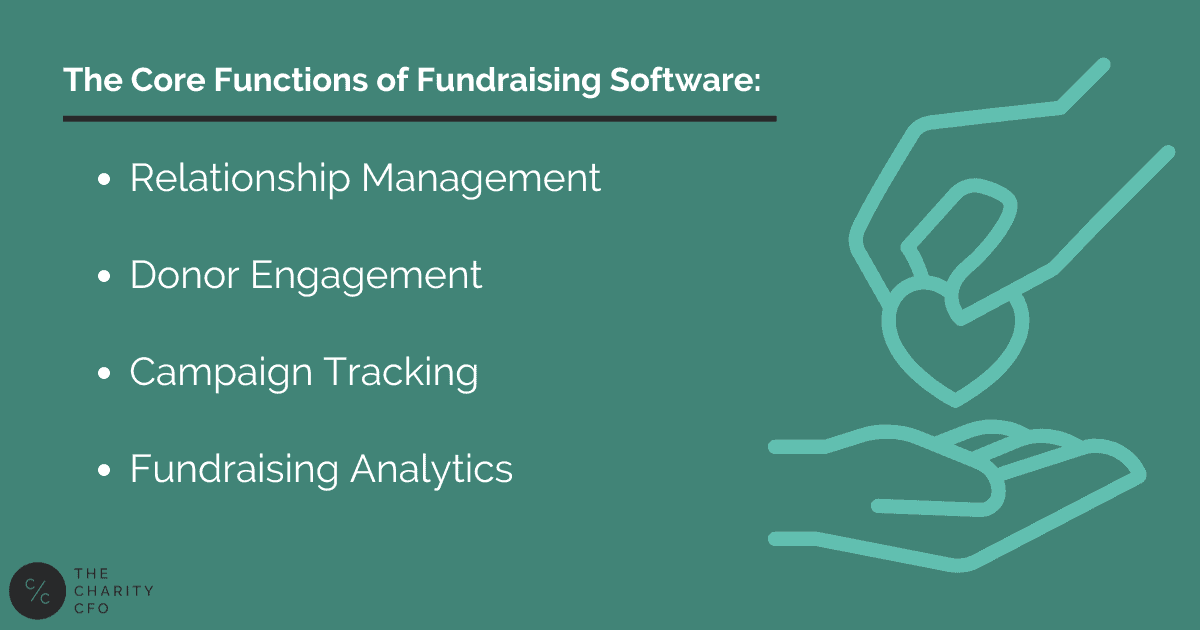The Dual Purposes of Accounting and Fundraising Software
Modern nonprofit leaders are always looking for ways to use technology to make everyday tasks easier. One of the most sought-after tools is a platform or software to integrate your fundraising and accounting data seamlessly. So why does it seem so hard to find this unicorn platform?
The short answer: these two datasets serve different purposes. This makes it challenging to create technology that tracks data for fundraising purposes while still following accounting principles.
Let’s explore why these two systems will likely never fully integrate by considering their separate purposes and data requirements.

The Core Functions of Fundraising Software
Fundraising software is a great way for your nonprofit to invest in technology and has four main purposes:
- Relationship Management: Helping you nurture donor relations
- Donor Engagement: Measuring the engagement of specific donors or donor demographics
- Campaign Tracking: Tracking the success of fundraising campaigns
- Fundraising Analytics: Giving you insights into your fundraising efforts
Each function helps fundraisers and nonprofit leaders gather and analyze data to make informed decisions that boost fundraising for the organization. To achieve this, fundraising software is flexible and customizable to meet the unique needs of different campaigns and donor interactions.
For example, fundraising software generally includes features such as:
- Donor segmentation
- Pledge tracking
- Event management
These features help you track and measure the success of various fundraising efforts, campaigns, and events.
The Core Functions of Accounting Software
Like fundraising software, accounting software uses technology to simplify your bookkeeping and accounting processes. The core functions of accounting software differ from fundraising software, as accounting tools are used for:
- Financial Reporting: Tracking revenue, expenses, assets, and liabilities in a structured manner
- Budget Management: Planning, monitoring, and adjusting budgets to properly allocate resources
- Compliance with GAAP (Generally Accepted Accounting Principles): Ensuring transparency and accuracy in financial data by adhering to GAAP
Accounting software doesn’t usually include a lot of customization features. Instead, accounting software prioritizes accuracy, standardization, and regulatory compliance. For example, some key features of accounting software include:
- Maintaining the general ledger
- Creating financial statements
- Accounts payable/receivable management
The Incompatibility of Fundraising and Accounting Data
The core functions of fundraising and accounting software play the main role in why you can’t integrate them. Specifically, there’s an inherent difference in data structure that makes it nearly impossible to combine them in a clean, usable way:
- Fundraising software tracks donor-centric data like donor preferences, relationships (i.e. individual and corporation connections), history, donor intent, or soft credits
- Accounting software tracks financial transactions with strict adherence to GAAP
Integrating two systems with fundamentally different data priorities can risk data inconsistencies, inaccuracies, and loss of information. This makes it difficult to maintain the integrity of both donor and financial records when attempting to sync the two systems.
The Impact of GAAP on Integration Efforts
We’ve mentioned GAAP several times, but why do these principles affect integration so much?
Generally Accepted Accounting Principles, or GAAP, is a set of standardized accounting rules and guidelines that govern how you report financial information. For nonprofits, GAAP ensures transparency, accuracy, and consistency in financial statements. Accurate and transparent financial data makes it easier for stakeholders and regulators to understand an organization’s financial health.
GAAP requires strict financial reporting, which may not align with the flexible, donor-centric data in fundraising software. This misalignment can make it challenging to add fundraising data into accounting systems without risking compliance or accuracy issues.
Let’s consider an example. You have a donor that has verbally pledged a $100,000 gift during a lunch – you have no written record. Accounting rules suggest (and your auditors would require) that this gift be made in writing. The fundraiser on your team would record this verbal pledge in their fundraising database – rightfully so. The verbal pledge does not meet accounting standards, so it should not be included in your accounting database. An integration, in this case would allow the fundraiser to inadvertently make changes to your accounting system that would result in a misstatement.
If you did try to integrate fundraising data into accounting systems, you run the risk of:
- Data inconsistencies
- Non-compliance with regulations
- Misallocation of funds
- Loss of public trust
Human Judgment Reigns Supreme
Technology is a great tool, but there are some things that just work better with a human touch. Interpreting and reconciling data between fundraising and accounting is one of those things.
Humans can interpret the nuanced behavior behind donor contributions to help ensure that restricted funds and donor preferences are accurately reflected in financial reports. Additionally, automated systems may not fully capture the complexities of donor intent or specific reporting requirements. Humans can provide necessary manual oversight to correct discrepancies and maintain accurate data.
For example, a human can track and manage a pledged donation to make sure it’s recorded properly whether it’s already received or has yet to be fulfilled. Soft credits also need manual reconciliation to ensure that they are accurately reflected in donor records without affecting accounting entries.
Alternative Approaches to Integration
You can still make sure your fundraising and accounting data align, even while managing them separately, following these best practices:
- Encourage regular communication and collaboration between the fundraising and accounting teams.
- Use data exports and reports to bridge the gap between the two systems.
- Implement workflow processes to ensure accurate and consistent data entry into both systems.
- Create a monthly reconciliation process between both databases.
Additionally, you can use third-party tools or middleware to facilitate limited integration without compromising data integrity. These systems automate data synchronization and transform data formats to align with the needs of both fundraising and accounting systems. For example, a system might validate and error-check data to identify and correct discrepancies.
Keeping Fundraising and Accounting Software Separate
The fundamental differences in fundraising and accounting data purpose and structure mean it’s unlikely your systems will ever fully integrate. And while that might sound like a drawback to the software, there’s many benefits to maintaining separate, specialized systems for fundraising and accounting. Using two separate tools makes it easier to keep your datasets clean and prevent data corruption–which is especially important for compliance purposes.
Although you can’t integrate fully, your organization can still use data from each software to help reach goals and advance your mission. Encourage open and regular communication between your fundraising and accounting teams for effective management of these critical functions.
Need some help interpreting your financial data? The Charity CFO provides expert financial advice and resources for nonprofits. Contact us today to learn more!







